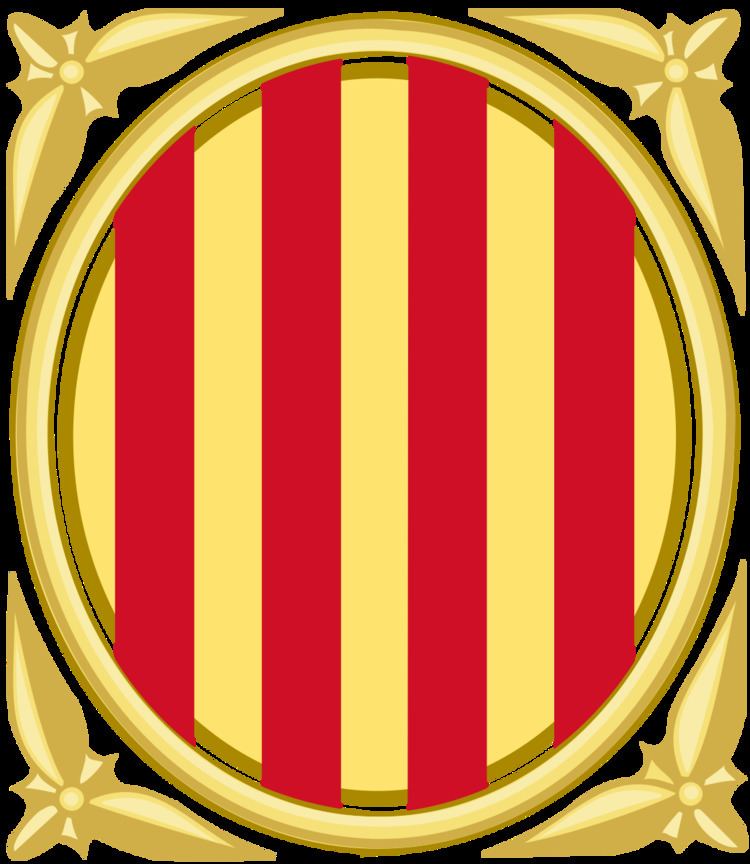Adopted 12th century | Crest Royal crown of Spain | |
 | ||
Escutcheon Or, four pallets gules. | ||
The Coat of arms of Catalonia is based on four red pallets on gold background which have been used since the Middle Ages on several coats of arms. Its origin is strongly related to that of the arms of the Crown of Aragon.
Contents
It is considered by heraldists and by the government of Catalonia to be originally the familiar arms of the Counts of Barcelona, and it was adopted by the descendants of Ramon Berenguer IV, Count of Barcelona as Kings of Aragon. Several authors strongly dispute the origin of coat and consider the arms to always have been those of the Kings of Aragon.
It is one of the oldest coats of arms in Europe dating back in a seal of Ramon Berenguer IV, Count of Barcelona from 1150.
Heraldic description
The blazon of the arms is: Or, four pallets of gules, ensigned with a royal crown. In heraldry, the escutcheon is traditionally called as of the King of Aragon, although some medieval armories display the same arms also on the entry for the Count of Barcelona. Modernly called of Aragon or of Barcelona.
It has been described on the Middle Ages armorials as in "Armorial du Hérault Vermandois", 1285-1300, as that of the King of Aragon, naming specifically Peter III as one of the bearers, is described as These are the arms of the Counts of Barcelona who acquired Aragón by marriage (...), the one of Count of Barcelona is the same or three pallets gules, the arms of the King of Majorca are those of Aragon, with the coat of arms of James II, King of Majorca being or four pallets gules a bend azure and the one of the King of Ternacle d Aragon et Ternacle en flanquiet lun dedans lautre (...) Per pale or four pallets gules and argent (...). The coat of arms with the four red pales on a gold background appears on several other coats of arms, named as "of Aragon". Also mentioned in Armorial de Gelre, 1370-1395, the coat of arms of Peter IV Die Coninc v. Arragoen is golden with four pallers of gulets (Barcelona) or the Armorial d'Urfé, 1380, sont les armes de le Conte de Cathalogne, and in armorial de Charolais, 1425, arms conte de Barselongne and armorial Le Blanq (sources from 1420-1450) venant des contes de Barselone, armorial Wijnbergen, King of Aragon or four pallets gules
History
According to those scholars who favor a Catalan origin, the red pallets on gold originally stood as the familiar emblem of the counts of Barcelona. The descendants of the Counts retained the symbol as Kings of Aragon (the main branch), Counts of Provence, Counts of Foix, Judges of Arborea in Sardinia (party per saltire), Kings of Mallorques, and Kings of Sicily (party per saltire).
As a pre-heraldic symbol, the red and yellow bars appeared on the Romanesque tombs of Barcelona's Count Ramon Berenguer II Cap d’estopes, (†1082), and of his great-grandmother Ermessenda, (†1058), wife of Count Ramon Borrell I, both of whose tombs were at the portico old Romanesque Cathedral of Girona. The dating of the tombs' paintings is controversial. Analysis of the painting showed that it coincided with paintings of the same times and the pre-heraldic forms indicate pre-heraldic times, before the second third of the 12th century.
The oldest seal including the arms dates from 1150: a seal of Raymond Berengar IV, Count of Barcelona and Prince of Aragon. The arms where inherited by all the three sons of Raymond Berengar, and they appear on the seals of Ramon Berenguer, count of Provence, from 1178, on the seal of Sanç, from 1180, and on the seal of the oldest brother, Alfons the Chaste, king of Aragon and count of Barcelona (1164-1196) from 1186. Some authors dispute the evidence of the seals; they claim that the first documented evidence dates from the reign of Alfonso II (king of Aragon and count of Barcelona, 1164-1196).
The chronicle of king Peter the Ceremonious, over 1359, says that the king-count Alfons the Chaste "left the arms and signals of Aragon and took pales", and the genealogy of the kings ordered by the future king John I, on 1380, states that Raymond Berengar IV "did not change the comital arms".
The Queen Consort Maria de Luna stated in 1396 in the Catalan Parliament that the arms of the County of Barcelona were "bars reds and yellows" and King Martin I in 1406 stated that the royal flag was the "flag of the old Principality of Catalonia".
